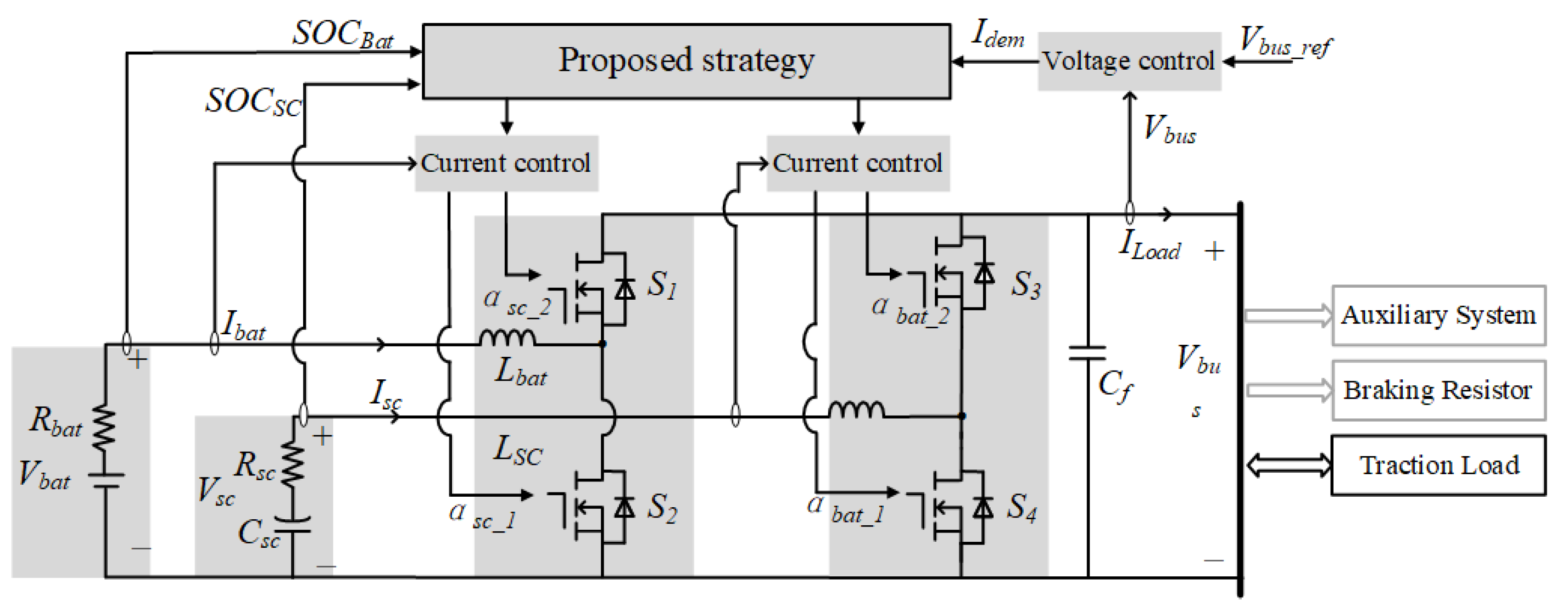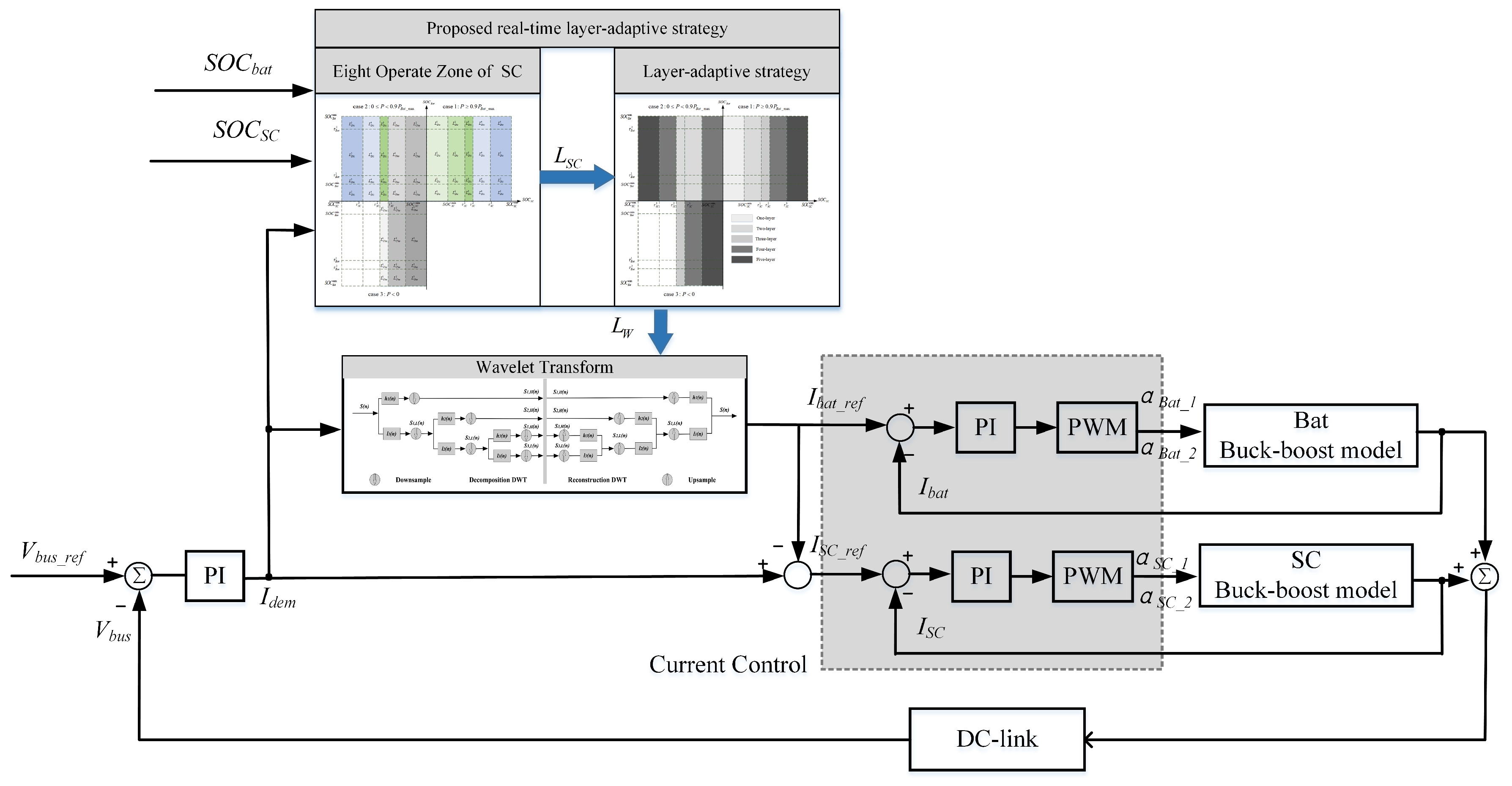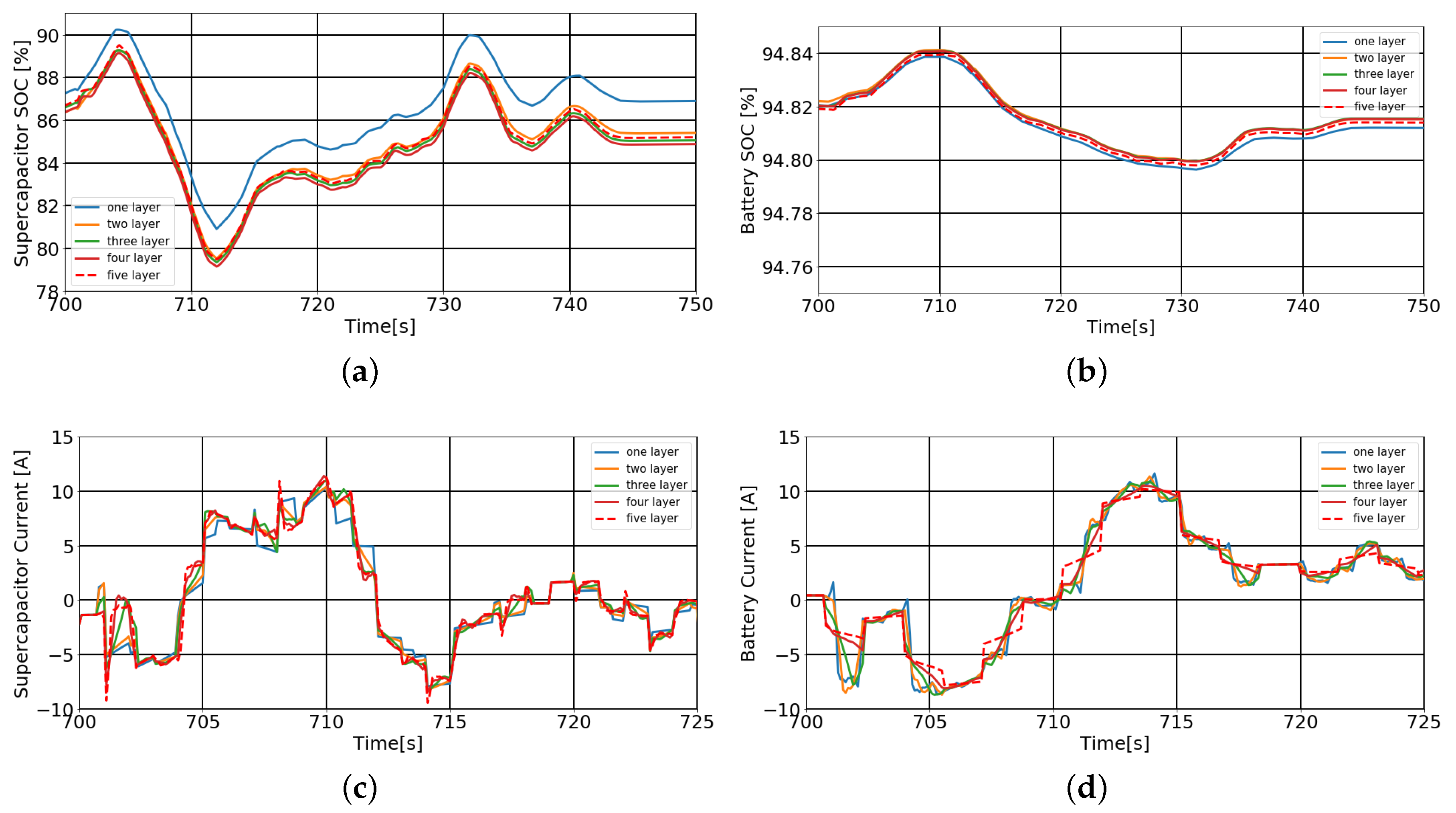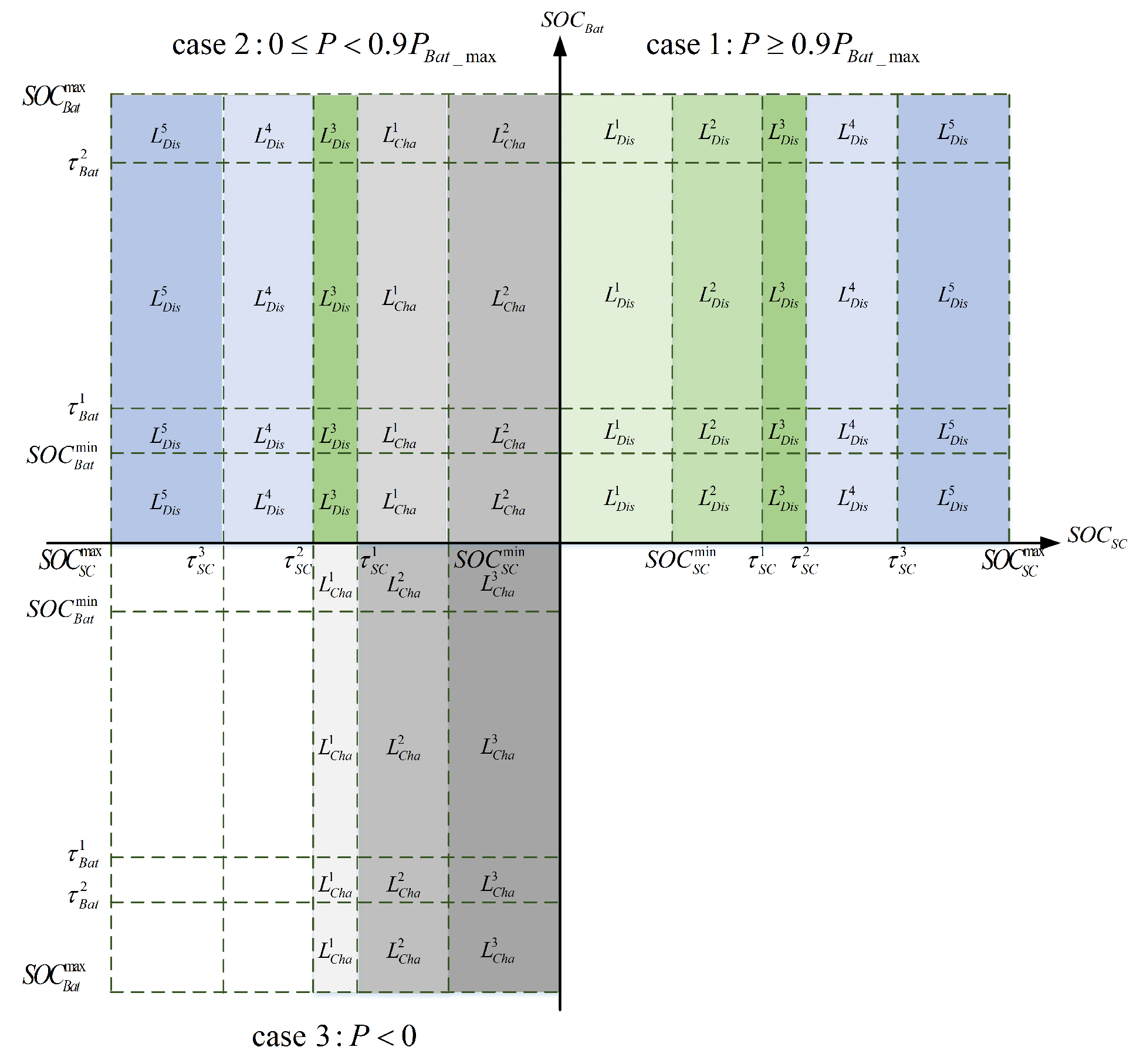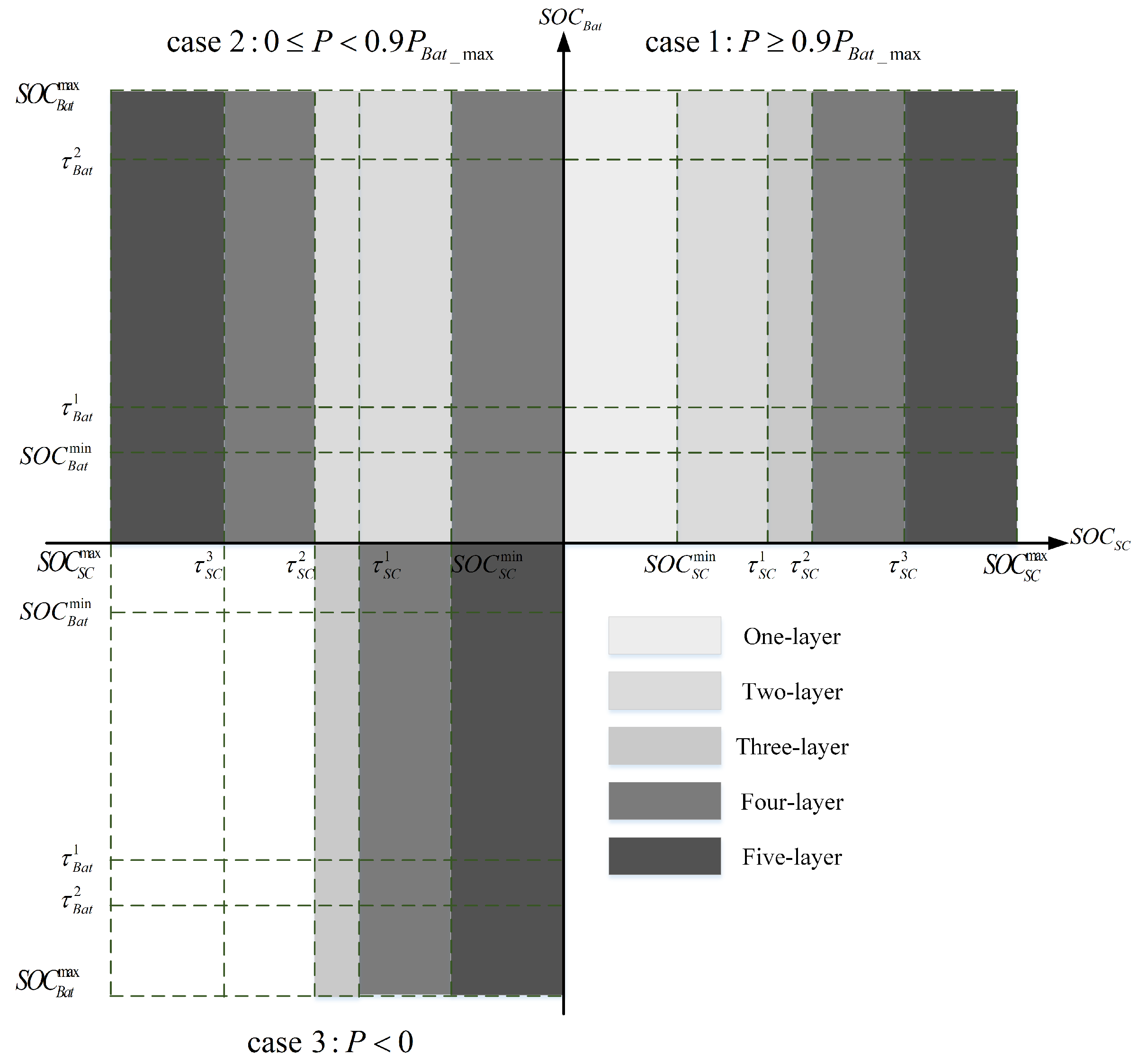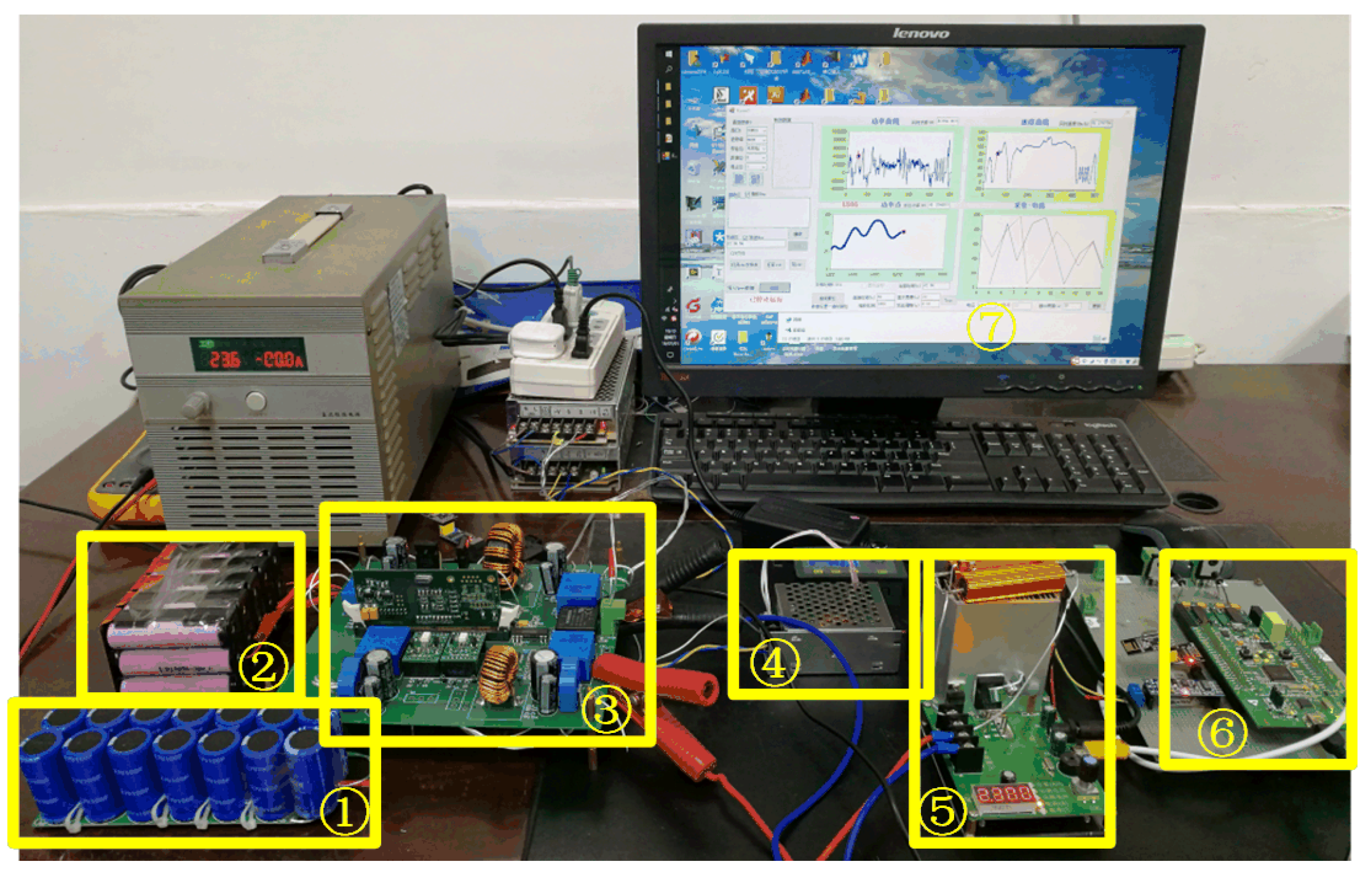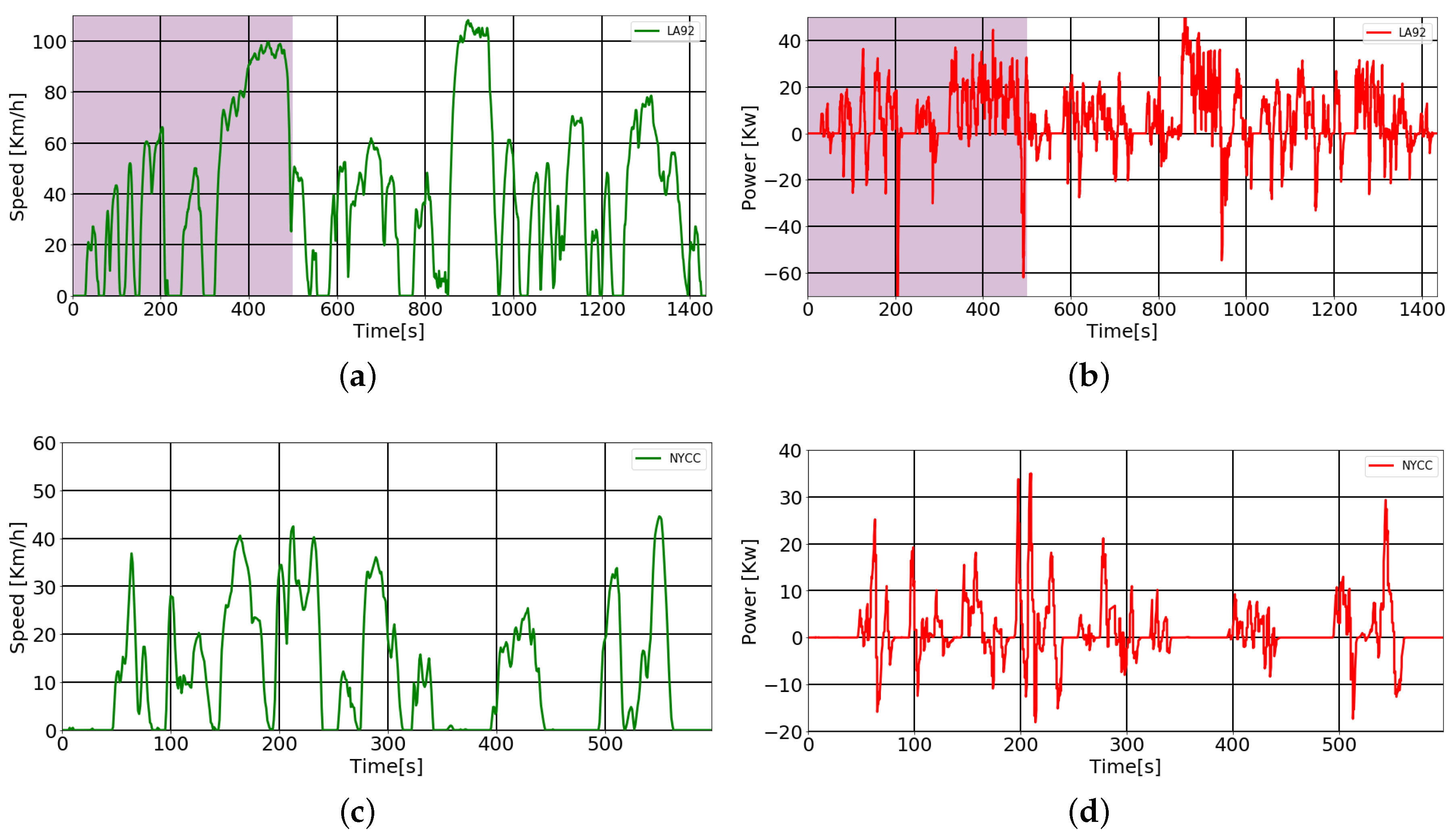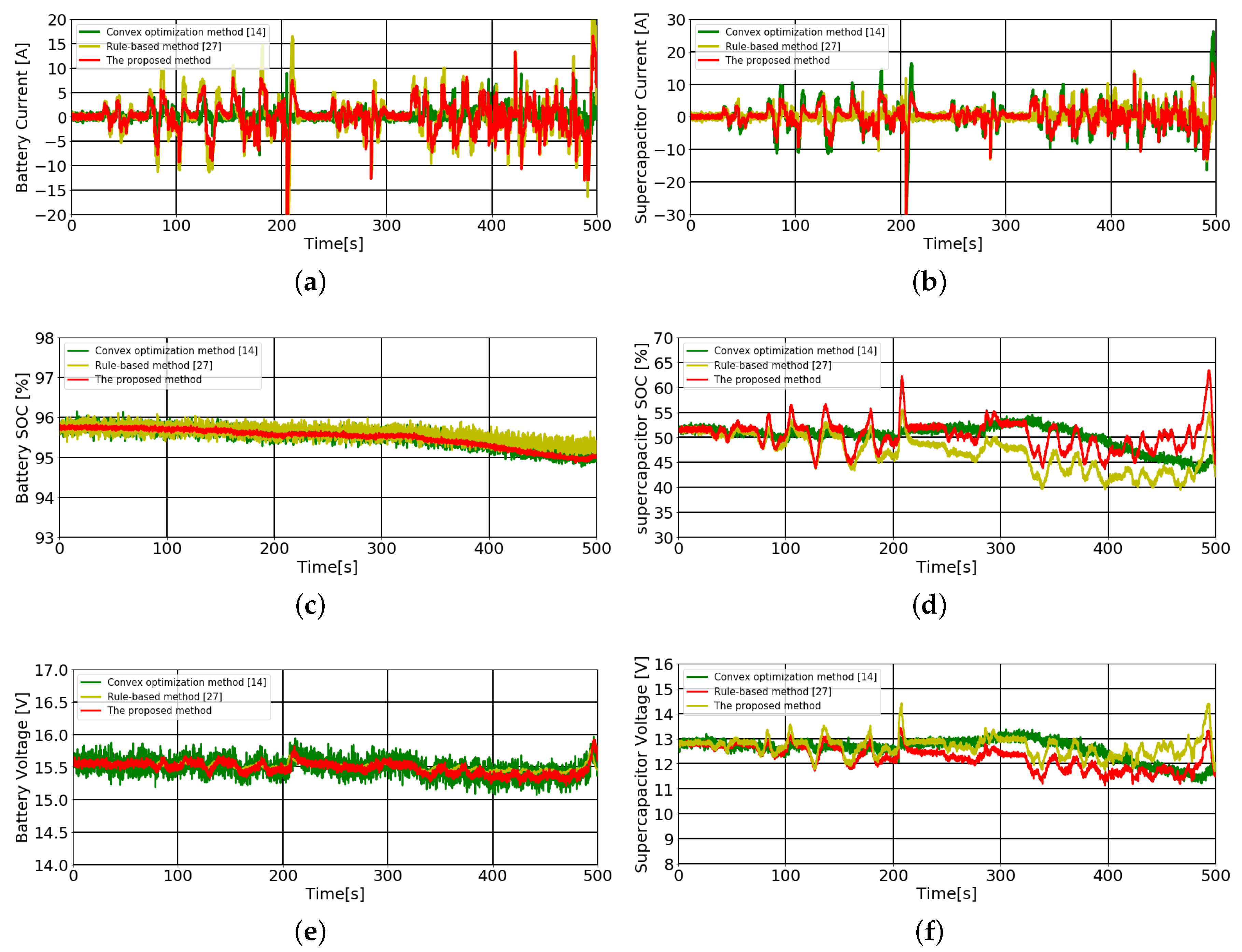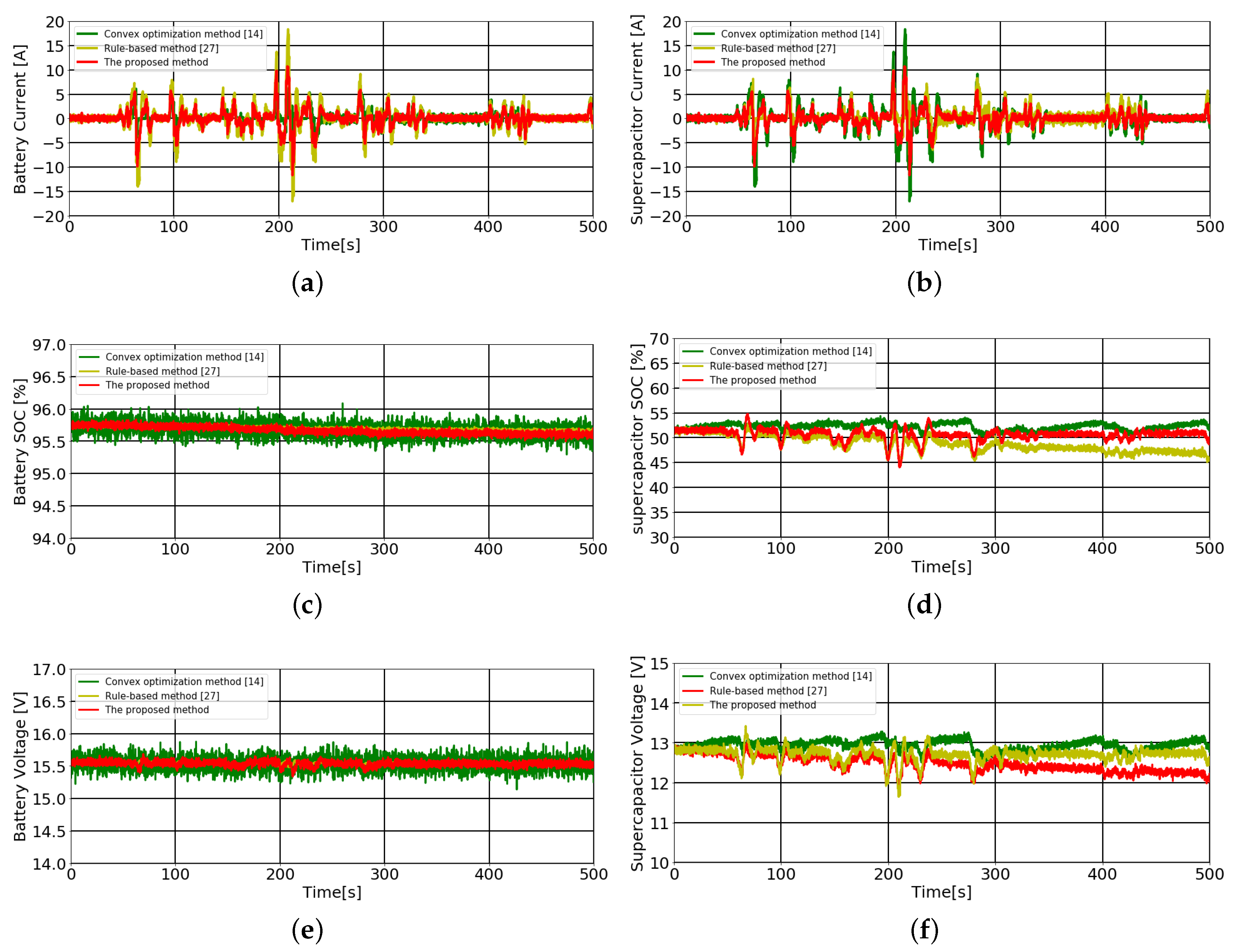1. Introduction
In recent years, electrical energy has received great attention due to its environmentally friendly and renewable advantages. Electric vehicles (EVs) and urban rail vehicle energy systems are good examples of applications that typically rely on energy sources such as batteries and supercapacitors to store electrical energy [
1,
2,
3,
4,
5]. Technologies adopted in most electric vehicles are diverse, but they only employ rechargeable batteries. The performance of battery energy management systems relies on the manufacturing technology and the specific application scenarios. Therefore, batteries are highly vulnerable to peak and turbulent energy demand caused by changeable driving road and traffic conditions, which compromise battery life, performance, and battery aging [
6].
To address these problems, one solution is to employ batteries and supercapacitors simultaneously to form a hybrid energy storage system (HESS), which profits from supercapacitors as the peak power buffer unit for fluctuating power demand [
7]. HESSs have been proposed in many works [
8,
9,
10,
11,
12]; they combine batteries and supercapacitors and consider their complementary characteristics. Batteries are considered for their high energy storage and supercapacitors are considered for their high power storage in an HESS, which can achieve a higher degree of practicality, such as a longer driving range, and a better performance of acceleration and feedback brake. HESSs route the low-frequency content of power demand into batteries and the high-frequency content into supercapacitors. The separation of power can effectively protect a battery’s life.
In general, an HESS topology can be categorized as three major types: the passive topology, the semi-active topology, and the fully active topology [
9]. The passive topology is the simplest and lowest-cost topology. The typical characteristic is the direct connection between batteries and supercapacitors in parallel and directly coupled to a DC bus [
10]. Although this topology is easy to implement in EVs, supercapacitors work as a low-pass filter, and the voltage of supercapacitors is limited, which results in their low efficiency. In the semi-active topology, a DC/DC converter is used to connect batteries and supercapacitors [
11]. The DC/DC converter permits the voltage of batteries/supercapacitors to be different from that of supercapacitors/batteries. This topology improves the flexibility and performance of the system and can reduce the system cost. The fully active topology employs two DC/DC converters to decouple the batteries and supercapacitors with a DC bus, which meets the required control performance owing to its flexibility of the voltage range in supercapacitors [
12]. Nevertheless, this topology demands compromise in terms of cost and efficiency weight volume.
The energy distribution in the hybrid energy system of electric vehicles is a key factor that determines the mileage of electric vehicles [
13]. It is particularly important to improve the life cycles of batteries and the overall performance of the HESS. Batteries have a high energy density and a low power density, while supercapacitors have a high power density and a low energy density. Therefore, the energy distribution strategies should distribute the low-frequency power to batteries and the high-frequency to supercapacitors. Many HESS control strategies have been proposed, which are mainly divided into two categories, i.e., off-line approaches and real-time approaches, according to the specific usage in real-time implementation, where the off-line optimization approach is to be used as the benchmark to verify the performance of other methods [
14].
Off-line approaches employ advanced optimization algorithms, such as dynamic programming, genetic algorithm, and particle swarm optimization [
15,
16]. Song et al. [
9] adopted a genetic algorithm to solve multi-objective optimization problems, minimizing the total loss of HESSs and battery capacity simultaneously. Choi et al. [
15] proposed an convex optimization strategy to achieve the minimization of the magnitude/fluctuation of the current flowing in and out of batteries and the energy loss seen by supercapacitors. Herrera et al. [
16] used the genetic algorithm to optimize the energy management system in economic terms, the cost of the energy absorbed from the catenary, and the cost of system operation. However, optimization algorithms are much more complex, which require heavy computation capability and time consumption.
Real-time approaches such as rule-based methods, model predictive control method, and frequency-based methods can achieve real-time energy distribution. A rule-based approach controls the energy flow in the HESS based on rules derived from expert experiences. Trovao et al. [
12] proposed a rule-based controller that considers the power demand of the load and the states of charge (SOCs) of batteries and supercapacitors simultaneously. Obviously, the rule-based method does not require any prior knowledge of the road conditions or load. It is developed based on the experience or heuristics of the experts and easily implemented. However, it does not consider the frequency components in the load demand, which is detrimental to battery life. Moreover, these rules are designed based on the initial state of the hybrid energy system and cannot accurately reflect the conditions of the system components after a long period of operation. Wang et al. [
13] proposed an average power-based model predictive control to achieve the energy distribution of the vehicle with multiple energy sources without any prior information of the drive cycles. However, model predictive control requires high accuracy of the model. Frequency-based approach methods such as frequency separation method [
17] consider high and low frequency components in load power demand, and two filters are used to achieve frequency separation. The cut-off frequency of the filters is switched between three candidate cut-off frequencies to achieve frequency separation. However, the cut-off frequency in the specific case is still fixed, without taking into account the specific changes in load power in specific situations. Li et al. [
18] uses three-layer wavelet transform to decompose the load power demand to energy sources. The low frequency components change with the specific load power demand when using wavelet decomposition for frequency separation [
19]. Therefore, the wavelet transform can decouple the high and low frequency components in the load demand and change with load demand.
This paper presents a real-time layer-adaptive wavelet transform strategy for the hybrid energy storage system of EVs. The load power demand and the SOC of the batteries and supercapacitors are taken into account to perform the real-time layer-adaptive wavelet transform energy distribution under the role of supercapacitors as the peak power buffer unit in the hybrid energy storage system.
The main contributions are summarized as follows:
(1) A real-time layer-adaptive wavelet transform energy distribution strategy is proposed to meet the load power demand and distribute the load power demand between batteries and supercapacitors. The number of decomposition layers of wavelet transform is determined based on the division of the operation zone of supercapacitors under the role of supercapacitors as the peak power buffer unit in the hybrid energy storage system.
(2) The SOC of supercapacitors is maintained within a predefined range by analyzing the SOCs of batteries and supercapacitors, and the load power demand. Supercapacitors are fully used as the peak power buffer unit to fully satisfy high frequency power.
(3) Extensive experimental results show that the proposed method provides a better real-time energy sharing between supercapacitors and batteries.
This paper is organized as follows.
Section 2 introduces the configuration of the hybrid energy management system and models the components in the hybrid energy management system.
Section 3 presents the energy distribution strategy proposed in this paper. Verification of experimental results is presented in
Section 4. The main conclusions are presented in
Section 5.
3. The Proposed Real-Time Layer-Adaptive Wavelet Transform Strategy
The sharp transient components contained in the load can cause significant damage to batteries. Therefore, the key to the energy management strategy is to distribute the high-frequency components of the load to supercapacitors and the low-frequency components to batteries. The bottom level of the strategy shown in
Figure 3 is a closed-loop control circuit that includes a voltage feedback outer loop, a battery current closed-loop circuit, and a supercapacitor current closed-loop circuit. The outer voltage loop generates a total reference current
that maintains the DC bus voltage stability, and the two inner current loops track the reference currents of batteries
and supercapacitors
, respectively. The duty ratios of DC/DC converters
,
,
, and
are obtained through current loops. The proposed strategy divides the total reference current
into two parts: the high-frequency part
and the low-frequency part
, which serve as reference currents for the current loops of batteries and supercapacitors, respectively.
In this paper, a real-time layer-adaptive wavelet transform strategy is proposed. The wavelet transform is a signal process method that has proven its usefulness in a variety of applications [
24]. Wavelet transform can extract characteristics of the transient signal and sharp changes in the load profile [
25]. Therefore, wavelet transform is used in this paper to decouple the high-frequency component and the low-frequency component of the load power. As shown in
Figure 4, the different frequency components can be achieved by multi-layer filtering. Haar wavelet transform is one of the simplest transformations in wavelet transform. The mother wavelet is Haar wavelet, which is a set of functions composed of a set of piecewise constant functions [
26], as shown in Equation (
16).
The discrete wavelet transform (DWT) is used to decompose a discretized signal into different resolution layers. The DWT can be expressed as follows:
where
represents the scale parameter.
u represents the position parameter. Wavelet coefficients
W is a function of
and
u. The wavelet
with different time-frequency width can be obtained by adjusting the scale parameter
and position parameter
u to match any position of the original signal
to achieve the purpose of time-frequency localization analysis of the signal.
As shown in
Figure 4, the frequency in the frequency part obtained by different layers of decomposition is different. The higher the layers of decomposition, the more power included in the high frequency portion. Supercapacitors as the peak power buffer unit have limited energy, so the number of decomposition layers is critical to the SOC of supercapacitors. This proposed strategy firstly compares the current and the SOC of batteries and supercapacitors under the wavelet transform of different decomposition layers on the driving cycle LA92.
3.1. Decomposition Layers for the Wavelet Transform
As shown in
Figure 5, when the wavelet transform of different layers is used, the SOC of batteries does not change significantly, while the SOC of supercapacitors has a significant difference. As the number of decomposition layers becomes higher and higher, the SOC of supercapacitors decreases faster, and the current of batteries also becomes smaller at the moment of the transient. Therefore, the higher the number of decomposition layers, the better the battery life, but there is an increase in the SOC consumption of the supercapacitors. Moreover, In order to maintain the SOC of the supercapacitors to cope with future instantaneous power, it makes sense to use different decomposition layers of wavelet transform. The SOC operation zone of supercapacitors is analyzed in the following section.
3.2. Operation Zones of Supercapacitors
The SOC of supercapacitors determines the amount of power they can supply to the load or absorb from the regenerative braking condition. As the peak energy buffer in the hybrid energy management system, supercapacitors should be fully utilized to ensure that supercapacitors respond quickly to power peaks during acceleration or absorb feedback energy in the braking condition. Therefore, the SOC of supercapacitors should always be kept within a preset range so that they can both provide high-frequency energy or absorb energy from regenerative braking at any moment. When the SOC of supercapacitors falls below this range, it should be charged by batteries or the load. When that goes out of range, it needs to be discharged to the preset range.
To keep the SOC of the supercapacitors within the most suitable range and maximize the SOC of the batteries, the SOCs of the supercapacitors and batteries are first analyzed in a two-dimensional coordinate system as shown in
Figure 6. The horizontal axis represents the SOC range of the supercapacitors and the vertical axis represents the SOC range of the batteries. SOC represents the discharge capacity in the positive half-axis and the charge capacity in the negative half-axis.
and
P denote the maximum current of batteries and the load power demand, respectively. According to the rule-based method, the load demand
is divided into three cases, namely
,
, and
. The operation zones of supercapacitors was analyzed under these three specific load power demand conditions.
The specific values of the nine thresholds
,
,
,
,
,
,
,
, and
for the batteries and supercapacitors in
Figure 6 are shown in
Table 2. As mentioned in the previous section, the minimum values for the batteries and supercapacitors are 20% and 25%, respectively. The supercapacitor acts as the peak power buffer unit, so its stored energy should be maintained at about half of full power. Therefore, its SOC preset range is 45% to 55% [
21]. In most cases, the SOC of batteries is within the two intermediate thresholds, namely
and
.
3.2.1.
According to
Table 2, the SOC combination of batteries and supercapacitors is divided into 20 cases in the first quadrant. Since the load power
P is greater than
, both batteries and supercapacitors should provide power to the load as much as possible. Therefore, the operation zones of supercapacitors is divided into five power supply situations according to the SOC of supercapacitors, and the power supply capability from the strong to the weak is
,
,
,
, and
, wherein the power supply capability of the
has the highest discharge capability.
3.2.2.
Since in the second quadrant, it is considered that batteries need to supply power to supercapacitors and the load at the same time. Due to the role of supercapacitors as the peak power buffer unit, the SOC of supercapacitors should be maintained in the range [, ]. Therefore, when the SOC of supercapacitors is less than 45%, batteries supply both the load and supercapacitors for future charging and discharging. At this point, there are two cases of operation zones for supercapacitors, and , respectively, and the charging power depends on the batteries and the load. When the SOC of supercapacitors is higher than , supercapacitors and batteries work together to supply the load, and supercapacitors have three kinds of operation zones, namely, , and .
3.2.3.
In the third quadrant, the electric vehicle is in the regenerative braking condition, and the hybrid energy system needs to absorb regenerative energy. The operation zone of supercapacitors is divided into three cases: , , and , in which has the highest charge capability.
Therefore, the operation zone of supercapacitors is divided into eight cases as shown in
Figure 6, namely,
. Cases
,
,
,
,
represent the discharge levels of supercapacitors, and cases
,
,
represent the charging levels of supercapacitors.
3.3. Adaptive Determination of the Wavelet Transform with Different Decomposition Layer
In the previous subsection, the operation zones of supercapacitors were divided into eight cases. Combined with the frequency domain distribution of historical power demand of the load, the specific decomposition layer of the load power demand was analyzed. Obviously, different operation zones of supercapacitors correspond to the wavelet transform with different decomposition layers.
It is worth noting that the high-frequency components of signals obtained by the wavelet transform of different frequencies are different even with the same number of decomposition layers. The high-frequency components and low-frequency components obtained by the wavelet transform vary with different driving cycles. Therefore, the use of the wavelet transform has good scalability to different driving cycles.
According to the analysis of the 1–5 layer wavelet transform in
Section 3.1, the wavelet transform of different decomposition layers corresponding to the operation zones of supercapacitors under three load power demand conditions is shown in
Figure 7. The analysis is as follows.
3.3.1.
In this case, the operation zones of supercapacitors are , , , , and . When = , the energy of supercapacitors is extremely low, hence the power allocated to supercapacitors should be as low as possible. The high frequency portion should contain as high a frequency as possible and as little energy as possible, thus performing a one-layer decomposition. When = , the supercapacitor is almost fully charged. In order to maintain supercapacitors as the peak power buffer unit, supercapacitors should be consumed as much as possible to the preset SOC range [, ].Therefore, the power allocated to supercapacitors should be as much as possible. The high-frequency part should contain a certain amount of energy, so a five-layer decomposition is performed. Therefore, the operation zones , , , , and correspond to the wavelet transform of the 1–5 decomposition layer, respectively.
3.3.2.
When
, the operation zones are
,
, and
, and the corresponding wavelet transform are five-layer, four-layer, and three-layer decomposition, respectively. When
, the operation zones of supercapacitors are
and
. At this time, no wavelet conversion is performed, and supercapacitors are charged by batteries. The power of batteries transferred to supercapacitors is calculated as follows:
The power provided by batteries is the sum of the supercapacitors and the load.
3.3.3.
In the case of braking conditions, supercapacitors should absorb as much regenerative energy as possible. The operation zones of supercapacitors , , and correspond to the wavelet transform of three-layer, four-layer, and five-layer decomposition, respectively.
The layers of wavelet decomposition depend on the SOCs of the energy sources and the current load power demand. After the wavelet decomposition of different layers, the high-frequency component and low-frequency component in the power demand is decomposed, in which the low-frequency component is used as the reference current of the batteries, and the high-frequency component is used as the reference current of the supercapacitors. This strategy achieves a real-time adaptive-layer wavelet transform energy distribution strategy and effectively protects batteries while making full use of supercapacitors. In addition, the computational cost and time consumption of the adaptive-layer wavelet transform strategy is lower than using only a five-layer decomposition of wavelet transform.
